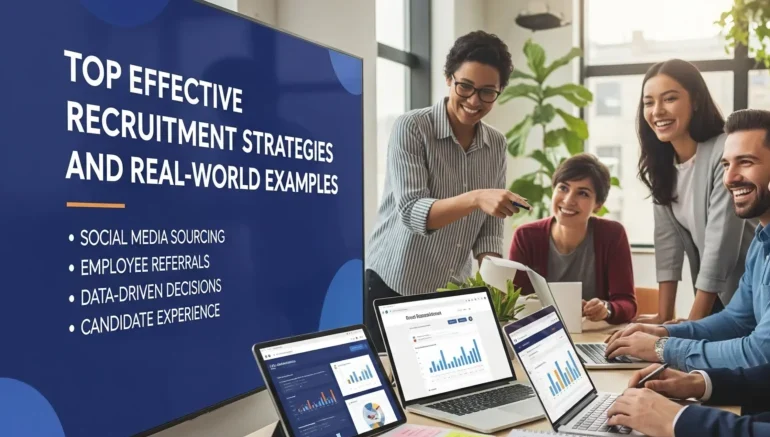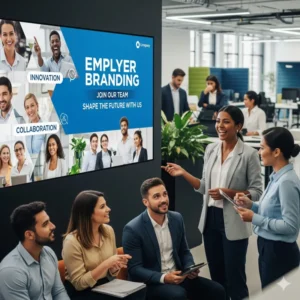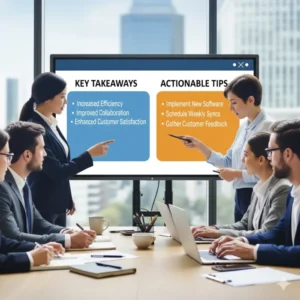
Effective Recruitment Strategies and Real-World Examples
The recruitment landscape has changed rapidly in recent years. With digital change, remote work, and evolving candidate expectations, companies must adapt to stay competitive. Traditional methods alone are no longer enough. Instead, organizations need effective recruitment strategies that attract, engage, and hire top talent by meeting candidates where they are and giving them strong reasons to join.
Modern recruitment is not just about filling vacancies; it’s about building long-term relationships and making sure that a great fit for both the company and the candidate. It combines marketing, data analytics, and employer branding into a holistic approach that addresses everything from candidate sourcing to go onboarding. With the job market becoming increasingly candidate-driven, companies must focus on delivering an exceptional experience throughout the recruitment journey.
As we explore top recruitment strategies, it’s important to understand that there is no one-size-fits-all solution. Each company has unique needs, cultures, and goals. However, by analyzing successful approaches and real-world examples, organizations can tailor and optimize their recruitment efforts to attract and retain the best talent.
Creating a Clear and Compelling Job Description
 A job description plays a key role in effective recruitment strategies. It’s often the first interaction a candidate has with your company, setting the tone and showing what to expect. A strong job description goes beyond listing duties, it reflects company culture, communicates transparency, and highlights the value for potential hires. When crafted well, it attracts the right talent and supports a smoother hiring process. Avoiding jargon and vague language is important. Instead of listing endless bullet points, focus on what success looks like in the role.
A job description plays a key role in effective recruitment strategies. It’s often the first interaction a candidate has with your company, setting the tone and showing what to expect. A strong job description goes beyond listing duties, it reflects company culture, communicates transparency, and highlights the value for potential hires. When crafted well, it attracts the right talent and supports a smoother hiring process. Avoiding jargon and vague language is important. Instead of listing endless bullet points, focus on what success looks like in the role.
Clarify how the position contributes to broader company goals and what growth opportunities exist. Use inclusive language to encourage a diverse pool of applicants and emphasize the company’s commitment to equity and development. Take Spotify, for instance. Their job postings clearly highlight their work culture, the mission behind the role, and what a candidate can expect from the team. This transparency helps filter applicants who are not just qualified, but genuinely excited about the opportunity, increasing the likelihood of a successful hire.
Using Employer Branding to Attract Top Talent
 Employer branding is more than just a buzzword; it’s a strategic asset. A strong employer brand communicates the values, culture, and benefits of working at your company. It helps candidates visualize themselves as part of your team before they even apply. This emotional connection can significantly boost the number and quality of applicants you attract.
Employer branding is more than just a buzzword; it’s a strategic asset. A strong employer brand communicates the values, culture, and benefits of working at your company. It helps candidates visualize themselves as part of your team before they even apply. This emotional connection can significantly boost the number and quality of applicants you attract.
Salesforce and Canva boost employer branding by showcasing employee stories, culture, and community involvement across social media and career platforms. These efforts humanize the brand and foster trust, especially among younger generations who value authenticity and purpose.
Effective recruitment strategies go beyond hiring, they also support retention. When employees connect with your mission and values, they stay engaged and loyal. A positive, transparent workplace not only attracts top talent but also builds pride and belonging within your current team.
Maximizing Social Media and Online Platforms
 Social media has become a strong recruitment strategies tool, enabling companies to reach a wider and more targeted audience. LinkedIn, Instagram, and TikTok help recruiters showcase culture, post job openings, and connect with passive candidates in creative ways. The key is to be strategic and consistent in your messaging.
Social media has become a strong recruitment strategies tool, enabling companies to reach a wider and more targeted audience. LinkedIn, Instagram, and TikTok help recruiters showcase culture, post job openings, and connect with passive candidates in creative ways. The key is to be strategic and consistent in your messaging.
Effective recruitment strategies often include more than job postings. For example, HubSpot uses LinkedIn to share employee stories, behind-the-scenes content, and thought leadership, creating a strong employer image.
Adding creative reels and short videos also helps attract potential candidates, even those not actively job hunting, by drawing them in with engaging content. Recruitment marketing on social media should align with your employer brand and provide value to your audience. This means sharing content that informs, entertains, and reflects the company’s values. It’s not about spamming job ads but creating an authentic presence that invites people to learn more and get involved.
Building an Effective Employee Referral Program
 An employee referral program taps into your most asset: your current team. Employees who refer to candidates often recommend people who align with the company’s culture and values. These hires are typically faster to onboard, more productive, and more likely to stay long term. That’s why companies with strong referral programs tend to see lower hiring costs and higher retention rates.
An employee referral program taps into your most asset: your current team. Employees who refer to candidates often recommend people who align with the company’s culture and values. These hires are typically faster to onboard, more productive, and more likely to stay long term. That’s why companies with strong referral programs tend to see lower hiring costs and higher retention rates.
To be effective, a referral program must be easy to use and rewarding. Offer incentives that resonate with your team, even if financial bonuses, extra time off, or public recognition. Clear communication about which roles are open and what kind of candidates are needed can also improve the quality of referrals.
Google has long relied on referrals as a key hiring channel.
Their program is simple but strong: employees are encouraged to refer candidates and are involved in the hiring process. This not only leads to quality hires but also increases employee engagement by making them active participants in the company’s growth.
Leveraging Recruitment Technology and Data
 The rise in recruitment technology has revolutionized the hiring process. Applicant Tracking Systems (ATS), AI-driven resume screeners, and analytics dashboards enable recruiters to work more efficiently and make data-backed decisions. This helps reduce bias, improve candidate matching, and streamline the hiring funnel. With data, recruiters see where top candidates come from, which job ads work best, and where applications drop off. These insights allow for continuous improvement and smarter allocation of resources.
The rise in recruitment technology has revolutionized the hiring process. Applicant Tracking Systems (ATS), AI-driven resume screeners, and analytics dashboards enable recruiters to work more efficiently and make data-backed decisions. This helps reduce bias, improve candidate matching, and streamline the hiring funnel. With data, recruiters see where top candidates come from, which job ads work best, and where applications drop off. These insights allow for continuous improvement and smarter allocation of resources.
Predictive analytics can even help forecast hiring needs and optimize workforce planning. Companies like IBM and Unilever have adopted advanced recruitment tech to improve their hiring strategies. Unilever, for example, uses AI to analyze video interviews, reducing time-to-hire while improving candidate experience. When implemented thoughtfully, technology becomes a strong partner in building a more agile and effective recruitment function.
Case Studies of Successful Recruitment Campaigns
 Real-world examples provide valuable insights into what works and why. For instance, Starbucks ran a campaign called “To Be Welcoming,” aimed at promoting inclusion and attracting a more diverse workforce. They used storytelling, employee videos, and targeted social ads to highlight their values and attract like-minded candidates.
Real-world examples provide valuable insights into what works and why. For instance, Starbucks ran a campaign called “To Be Welcoming,” aimed at promoting inclusion and attracting a more diverse workforce. They used storytelling, employee videos, and targeted social ads to highlight their values and attract like-minded candidates.
Another standout is McKinsey & Company’s campus recruitment initiative. By hosting live Q&A sessions, workshops, and competitions, they not only attracted top-tier talent but also built strong brand recognition among students. Their strategy focused on building relationships rather than just filling roles, resulting in a highly engaged talent pipeline.
Meanwhile, the U.S. Army’s “What’s Your Warrior?” campaign modernized military recruitment with personalized digital content aimed at Gen Z. This campaign shifted perceptions and drove higher engagement through immersive storytelling and targeted messaging. Each of these examples highlights the strength of creativity and alignment with audience values in recruitment success.
Key Takeaways and Actionable Tips
 Effective recruitment isn’t just about adopting trendy strategies; it’s about aligning those strategies with your organization’s goals and culture. Crafting clear job descriptions, showcasing an authentic employer brand, and utilizing social media are all important steps toward attracting the right talent. When these elements work together, the hiring process becomes more streamlined and impactful.
Effective recruitment isn’t just about adopting trendy strategies; it’s about aligning those strategies with your organization’s goals and culture. Crafting clear job descriptions, showcasing an authentic employer brand, and utilizing social media are all important steps toward attracting the right talent. When these elements work together, the hiring process becomes more streamlined and impactful.
Don’t overlook the strength of your current team. Employee referral programs and internal engagement can significantly amplify your recruitment reach and improve retention.
Meanwhile, leveraging technology allows you to optimize your efforts and make smarter, data-informed decisions. The key is consistency and intentionality. By learning from real-world examples and continuously refining your approach, you can build a recruitment strategy that not only fills roles but strengthens your organization from within. Even if a small business or global brand, these strategies offer a clear roadmap to hiring success in today’s competitive talent market.
Conclusion
The recruitment landscape has evolved dramatically, and organizations must adapt to meet the challenges of today’s competitive job market. By using recruitment technology, data, social media, and employer branding, companies can now attract top talent more effectively and actively. A strong employer brand and clear job description attract candidates while building lasting relationships with those aligned to company values.
Implementing strategies such as employee referral programs, recruitment technology, and real-world campaigns can lead to better-quality hires, improved employee retention, and a more streamlined recruitment process. Each approach, when done thoughtfully, helps attract the right candidates, cut hiring costs, and make sure that positive candidate experience. Aligning recruitment with company values and culture gives organizations a competitive edge in attracting and keeping top talent.
Recruitment will keep evolving, but the key remains the same, building real, lasting connections with candidates. If scaling a startup or refining corporate hiring, using modern strategies and real-world examples positions you for success in today’s talent market. With the right mix of creativity, technology, and engagement, your recruitment strategy can be a strong driver of growth and success.
Read Next: Hiring Process Steps for 2025 – Recruitment Processes





